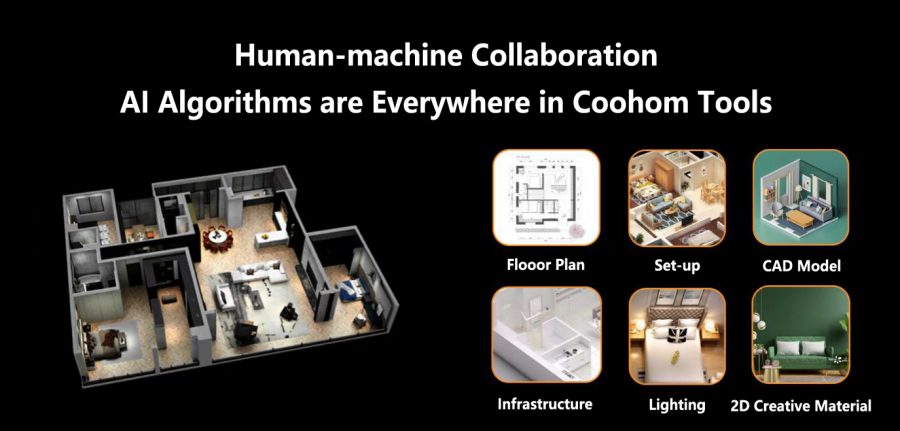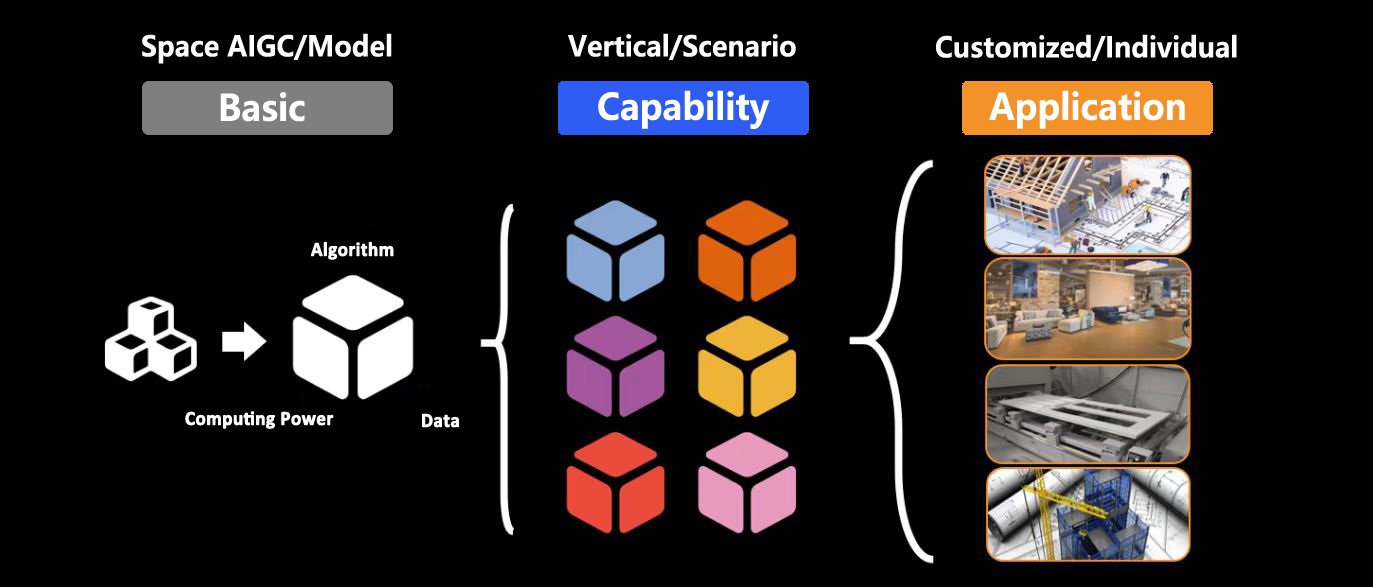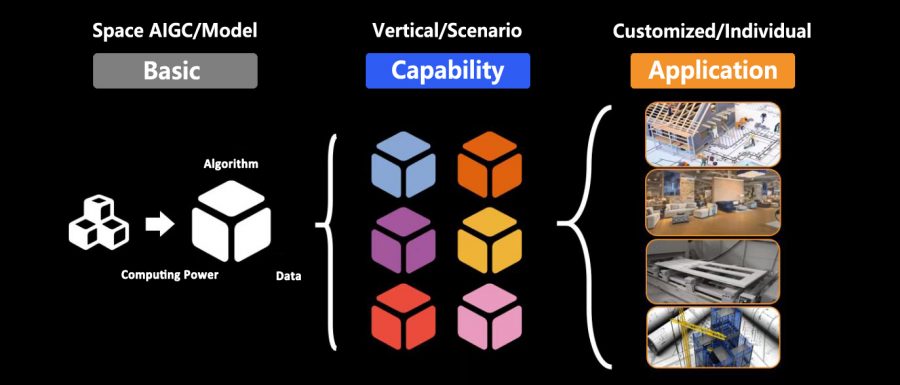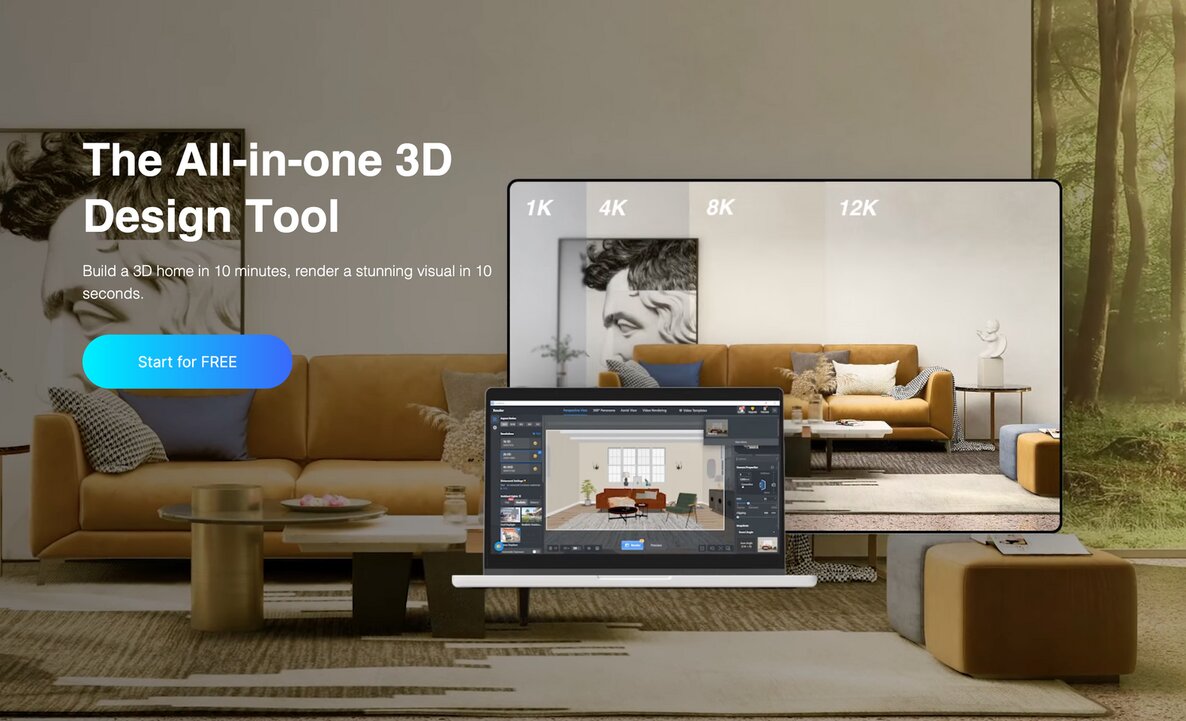The future paradigm of space AIGC: algorithmic model as a service
“In face of AIGC ‘invasion’, we have no choice but to face and harness it.” Zhou Zihan, Head & Chief Scientist of the Coohom Frontier Technology Research Institute said at the 2023 Manycore Product Launch.
AIGC is like the industrial revolution in content creation. As the era of large-scale computing power arrives, there will be great transformations in the mode of content creation. What Manycore wants to do is to be the pioneer of AIGC in all-in-one design field and help users use this tool to their advantages.
In this context, Manycore announced the establishment of AIGC Lab, which will focus on the application of “Space AIGC” scenarios, including AI design generation and iterative creation for home decoration, commercial space, real estate and architecture in 3D design, and exploration of PPT generation in 2D scenes.
The scientist proposes that AIGC Lab will realize a future paradigm of “Model as a Service”, providing unlimited creative opportunities for AIGC’s users and enterprises to achieve free and flexible creative design through AI.In the future, he will lead the lab’s research in generative AI. Zhou has been dedicated to studying computer vision and machine learning, and is a “National Overseas High-Level Talent”. Before joining Manycore, he was an assistant professor at Pennsylvania State University.
How to Make Use of AIGC in 3D Design
2022 is regarded as The Year of AIGC. According to the 2022 top 10 scientific breakthroughs, released by Science on last December 16, AIGC was one of them. AIGC represents the liberation of content productivity and the creation of more diverse content with higher efficiency and lower cost.
AIGC is about contents and scenarios in essence, both of which are generated by data, algorithms and arithmetic power. Given the computing power of nearly 10,000 self-researched servers worldwide, Manycore has seen its data grow exponentially. It now owns over 270 million product models and has more than 3.3 billion rendering images. 90% of the floor plans for houses and apartments built in the past five years are in its collection. Based on the massive 3D models, 3D design content database, and research on the underlying artificial intelligence technology, Manycore has been expanding the AIGC applications in 3D design.
For Manycore, AI plus design has been one of its core research fields. In AI intelligent design, many of its research papers have been selected for SIGGRAPH Asia, CVPR, ECCV and other international academic summits. The company has applied for 332 patents in total, covering deep learning datasets, image generation 3D models, and automatic generation of indoor scenes through language input, among others. It’s safe to say that Manycore has already taken the lead in space AIGC technology and its application.
Manycore is committed to building an industrial grade, cloud-based CAD platform for large application scenarios in manufacturing and construction industries such as home design and decor, architecture, and commercial spaces. Unlike various forms of AI-generated images and text, the company focuses on 3D scenes. This requires not only technical breakthroughs, but more importantly, a better understanding of complex industrial logic and intelligent collaboration across the whole life cycle and the industry chain.
Focus on Human-machine Collaboration, to be Pioneer of space AIGC
Whether the cutting-edge technology can bring “welfare” for users and enterprises need to be tested by the market. As a decade-old technology-driven company in home design, Coohom has withstood the test of the market time and again.
Several years back, the company launched AI intelligent design products, helping to generate a home design plan in as fast as 5 minutes. The product focuses on solving the problem of repetitive operations by quickly collecting and understanding design requirements, and converting design rules into machine language; through “sample room design”, some repetitive work in the home design is automated.
However, creativity is an iterative process of divergent thinking. That means AI undertakes more basic or manual work while human dominates the part that requires much intelligence and creativity.Therefore, Manycore has been focusing on the “human-computer co-creation” mode as the breakthrough of AI intelligent design, and deeply combining AI algorithms with “user editing” design method. From the user’s perspective, Coohom has taken into account the workflow of design users and keeps exploring the potential needs of users creating designs. Now AI algorithm has become essential, ranging from the automatic import of floor plan during resign, to the smart design of furniture model, design plan and construction drawings, and to the one-click generation of short video in marketing, the virtual live room for online streaming, as well as the AI generation of PPT proposal in 2Dscene. In the future of stronger AIGC infrastructure and larger industrial applications, a more complex and diversified content ecology will surely grow.

In addition to the above applications, the launch event also witnessed several new products such as the 3D AI assistant, AI one-click lighting and AI proposal. As the research result of “AI automatic generation of 3D lighting” project of KooLab of Manycore, CAD&CG Lab of Zhejiang University and Light Cloud Technology, the AI one-click lighting is introduced in a paper published on ACM Transactions On Graphics in 2023.
The Future Paradigm of space AIGC: Model as a Service
With the deeper application of AI algorithms, Manycore has gained insights into demand for AI from an increasing number of industries. So the core challenge is how to make AIGC more flexible to serve industries and designers in various fields and solve the problems unique to each application scenario.
“The solution is no longer to develop AI algorithms or train machine learning models for each need,but to practice Model as a Service, under the principle of which, the model is open to everybody as a service so that more people can access the AI capabilities to meet their personalized scenarios easily based on the framework we provide.” Zhou Zihan said.
According to Zhou Zihan, the MaaS-based space AIGC industry can be roughly divided into three parts.
The first layer is the foundation, which means providing a common AIGC algorithm model for 3D space, that is, building the infrastructure of space AIGC. “The key to achieving this goal is to fully integrate the algorithm model with the exponential growth of GPU computing power and 3D design data of Manycore.”
Secondly, based on the generic model, enterprises and partners of Manycore can quickly make adjustments based on specific scenarios and realize their pipelined deployment in different business scenarios.
Finally, the application. The AIGC model connects the needs of each user to produce a richer content ecology for all-in-one design, for example, construction drawings, furniture models, short videos and other AI-generated design solutions mentioned above. The goal is to ensure AIGC reaches a wide range of designers.
Just as Zhou Zihan showed at the event, based on the text, scene, space, inspiration map, description and other information input by users, AI will create infinite possibilities to realize “what users think is what users get”. Of course, in his view, it is necessary to realize that AIGC cannot completely replace UGC, and the machine can never have human thinking ability, but the tool can always be used by human beings and become an assistant to improve production methods. According to Gartner, by 2025, Generative AI content will account for 10% of all generated data. Currently, the rate is less than 1%, representing a vast market before a new business order is established. Whether it is the underlying technology or the industrial application, Manycore has laid a solid foundation and will continue to develop a more mature AI creation model as an innovator.


